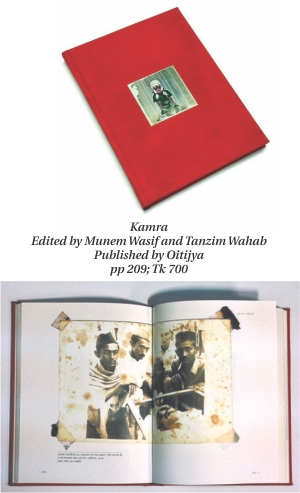| Home - Back Issues - The Team - Contact Us |
 |
| Volume 11 |Issue 19 | May 11, 2012 | |
|
|
Book Review Photography in Rearview Sabhanaz Rashid Diya Strapped in an impressive red bound edition, Kamra, written in Bangla takes a self-challenging insight into the most defining moments of photography. It not only explores the positive progression of the art, but also brings forth its many criticisms – thereby providing readers with an honest perspective that responds and questions simultaneously. Kamra is derived from camera obscura (Latin) that describes an optical device that projects an image on a screen and one of the early inventions that led to photography. For Munem Wasif and Tanzim Wahab, the interpretation of the term goes beyond its physical presence, and presents itself as a pinching reminder of the origins of photography and its many tumults. While the form has always been disputed over its establishment as an art form and criticised for its dependency on machines and technology, Kamra defies and adds to the dispute, and is an intriguing reiteration of the many realms of photography.
Yet, it does not stop there. Wasif and Tanzim take their passions a step forward by bringing the phenomenon to the East and share a rarely unheard story of photography in Bangladesh. Compiling interviews and essays from Nasir Ali Mamun, Dr Nawajesh Ahmed, Bijon Sarker and many others, Kamra stands as a significant reference of the most important conversations of time. Sukumar Ray and Raghubir Singh shed cultural perspective into modern photography, while oral histories from masters of Bangladesh provide a more authentic record of its evolution. The book also combines a portfolio of family photographs alongside a series of iconic photographers to create a surprising contrast while exploring two important interpretations of the history of photography, and its ability to influence or be influenced by society. An icing on the cake is revealed on the back flap firisti by Wasif and Tanzim that not only elaborates their intention behind producing such a book, but also poses questions and opinions on photography's most recent discourses, thereby catalysing what will soon become some of the most defining and necessary dialogues of the fast-paced globalised world. In most cases, those writing about art are not the artists themselves, rather those who hold it close to their intellects. Kamra's most inspired aspect is the fact it is the work of photographers and provides a gripping and refreshing perspective into how artists view their art. It is often said a photograph is worth a million words, and Kamra is a fascinating set of million words about a photograph. Now is the best of times and the worst of times. At a time when photography is finding its place as an exciting art form, Kamra stands as a critical pivot between the past and future – and is unquestionably a must read for those seeking to explore photography and art.
Copyright
(R) thedailystar.net 2012 |
 Kamra opens with this very critique by French poet and art critic Charles Baudelaire, who challenged photography's label as 'art' and through essays and interviews, explores its constant demarcation from traditional art forms such as painting and its somewhat dubious establishment as an 'art' form. It is this very negative yet striking beginning to the book that hooks the reader till the final pages, telling a story untold to many and providing those exploring photography a jolting insight into why and how photography is what it is today.
Kamra opens with this very critique by French poet and art critic Charles Baudelaire, who challenged photography's label as 'art' and through essays and interviews, explores its constant demarcation from traditional art forms such as painting and its somewhat dubious establishment as an 'art' form. It is this very negative yet striking beginning to the book that hooks the reader till the final pages, telling a story untold to many and providing those exploring photography a jolting insight into why and how photography is what it is today.